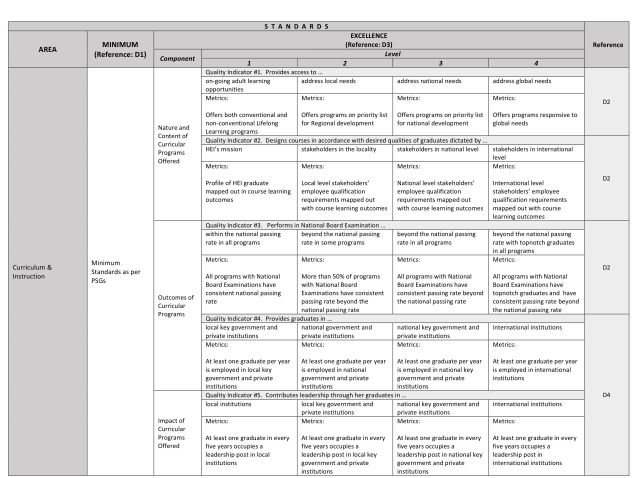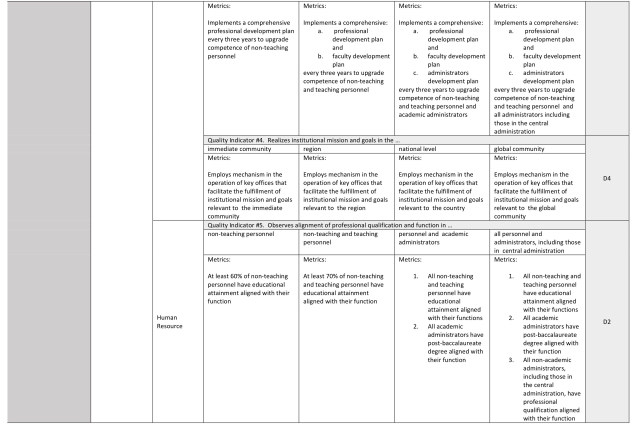Talking Points Towards a Revision of Policy-Standard to Enhance Quality Assurance (QA) in the Philippine Higher Education through an Outcomes-Based[1] and Typology-Based[2] QA (CMO 46 s. 2012).
Fr. Joel Tabora, SJ, Dr. Gina Montalan, Atty. Faye Risonar-Bello. Version Jan. 6, 2019 presented to CHED Chair Prospero de Vera on Jan 7 with consent of heads of COCOPEA. Chair de Vera recommends continued discussion of and development of this proposal within COCOPEA. He would be willing to listen to COCOPEA views on this during a convocation called for this discussion.
- It would help the promotion of Quality Assurance in Philippine Higher Education if its Policy Standard simply focused on Quality (Q) and Quality Assurance (QA).[Cf: Higher Education Quality Framework, attached]
Quality
- Quality in higher education (Q) has to do with four essential dimensions: (1) the achievement by the HEI of minimum standards set by government[3]; (2) the implementation of the vision and mission of the HEI; (3) the achievement of standards of excellence by the HEI; and (4) the responsiveness of the HEI to stakeholders[4].
- Government prescribes minimum standards in its regulative function; it recognizes and encourages exemplary implementation of vision and mission, excellence in learning outcomes, and high responsiveness to stakeholders in its developmental function.
- In achieving minimum standards but especially in surpassing them, HEIs function in academic freedom. Academic freedom is vested in the HEI by the Philippine Constitution; it is guaranteed by RA 7722.
- The academic freedom of the HEI is its recognized ability to achieve the minimum standards set by government, to implement its mission appropriate to its vision (identity), to achieve standards of excellence in learning outcomes, and to satisfy its particular stakeholders as a responsible part of the PH system of education under current historical conditions.[5] HEIs individually and as a community govern themselves in academic freedom. Academic freedom is realized in academic responsibility.
- It is in the interest of the one PH system of education that minimum standards be kept minimum, to empower HEIs in academic freedom to distinguish[6] themselves in implementation of the HEI vision and mission, in excellence in the achievement of learning outcomes, and in responsiveness to stakeholders. Unto this end the process of determining minimum standards in consultation with the HEI community (through PASUC and COCOPEA) should be clarified.
- HEIs distinguish themselves by surpassing minimum standards in academic freedom through evidenced performance against an array of indicators of (four?) levels of excellence in the implementation of vision and mission, learning outcomes, and in satisfaction of stakeholders. HEIs may distinguish themselves either in achieving all the excellence indicators of one level, level by level, or in achieving some indicators in different levels of excellence. The achievement of excellence is iterative and an ongoing demand of academic freedom.[7][Cf. Table of Areas of Excellence (Faculty, Administration, Research-Publications-Innovations, Community Engagement) and Quality Indicators on 4 Levels (for discussion and refinement), attached. Quality Indicators to be assigned points through which HEI distinguish themselves.]
- In academic freedom the HEI declares that it has achieved minimum standards and how it has distinguished itself as an HEI in the implementation of its vision mission, in the achievement of excellence in learning outcomes, and in responsiveness to stakeholders.
Quality Assurance
- Quality assurance (QA) checks that what the HEI has declared is in fact true. It assures both the HEI and its stakeholders that that quality the HEI claims is in fact true.
- The culture of QA is the development or acceptance of systematic internal and external checks and metrics of quality by the HEI.
- In academic freedom, the HEI has the primary responsibility for Q and for QA. CHED encourages and promotes QA in its developmental function, since QA necessarily bring the HEI beyond minimum standards.
- QA ascertains that the HEI has achieved minimum standards and ascertains indicators of excellence.
- The Philippines is part of the ASEAN Quality Assurance Network (AQAN). It subscribes to the ASEAN Quality Assurance Framework (AQAF). This requires the External Quality Assurance Agency (EQAA), the EQAA Standards and Procedures (EQAA-SP), the Internal quality Assurance structure (IQA), and the National Qualifications Framework (NQnF), i.e., the Philippine Qualifications Framework. [Note important difference between Q and Qn!]
- The HEI distinguishes itself in Q and seeks confirmation of this through QA.
- Government recognizes how the HEI has distinguished itself in Q through QA, ultimately, through the judgements of the EQAA. In recognition of a distinguished HEI it may reward it through such incentives as scholarship grants, grants towards institutional development, the status and privileges of autonomy, center of excellence, center of development for excellence, prior access to TES funds under title of quality higher education, etc[CHED could reward excellence on the basis of points earned for indicators of excellence, cf. 7]
- The ultimate beneficiary of Q and QA must be the stakeholders (humane human society in the PH, the industry that promotes this). The most substantial contribution of the HEI to its stakeholders is its graduates.
Higher Education Quality Framework








